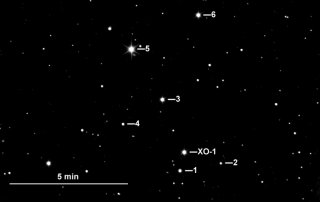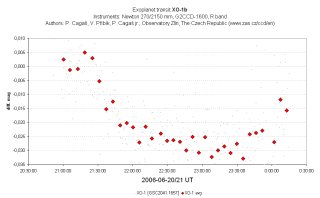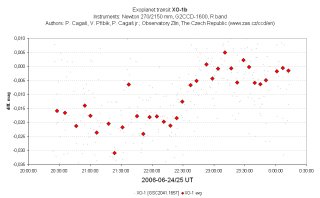|
The XO-1 star is very similar to our Sun. It has almost the same
diameter and mass and its spectral type is G1V. Its brightness is
11m and distance approx. 200 (±20) pc. Star coordinates are
R.A. = 16h 02m 12s and Dec. = +28° 10’ 11”.

XO-1 field with comparison stars in red color The XO-1b planet is very similar to our Jupiter, it is only a bit
larger (approx. 1.3 times) and lighter (its mass is
0.9 MJ). But it orbits much closer to
its sun—approx.
0.04 AU. The orbital
period is only 3.94 days.
The planet transit lasts for about 3.5 hours. But
XO-1b transits observable from the Czech Republic appeared on the end
of June, when the night is very short. The middle of the transit must
occur close to midnight if we wat to observe the whole event. Either
way we must start measurement in twilight and finish it on dawn.
The first observable XO-1b transit occurred on June
17th, 2006. The weather was too bad this day so we waited
till June 20th and 24th.
The sky was clear on June 20th and the night was
exceptionally suitable for astronomical observations. Although the
astronomical night did not occur (the Sun passed too close below
horizon at midnight at our latitude), clear atmosphere scattered only
little sunlight and light pollution of the nearby city Zlin.

The first detected XO-1b transit The expected brightness drop only 0.03m
is so small that we did not know if we can detect it at all. The
resulting light curve shows that with quality CCD camera we can
observe such events.
We already knew what to expect on June 24th. The weather
was much worse and the second half of the night was really bad with
high clouds and haze in the atmosphere. Still the XO-1b transit is
clearly visible.

The second detected XO-1b transit Although we started observations on twilight, we missed the actual
planet entry and the initial brightness drop.
It is necessary to fulfill two conditions to successfully observe
extremely low brightness drops caused by exoplanet transits—it is necessary to observe through a filter (preferably
a red one) and to guide all exposures to keep observed star and
reference star images on the same pixels of the CCD chip. We did not
utilize auto guider so the star images wandered around the CCD chip
during observations. Still we achieved very good results. The
precision should improve significantly when we start to use auto
guiding.
The event was observed at the Zlin city observatory using
27 cm f/8 Newtonian reflector and
G2CCD-1600 camera.
All images on this page by Pavel Cagas, Vaclav Pribik and Petr
Cagas.
| 